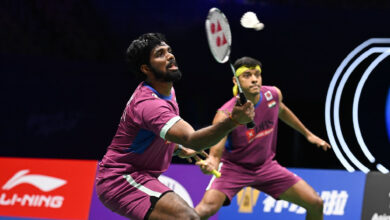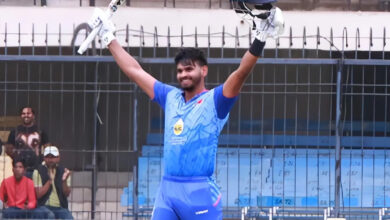PV Sindhu has been grinding it out leading to the Olympics, but is it a good thing? | Badminton News

Maybe none of the past matters, because it is the Olympics and because it is PV Sindhu at the Games. Perhaps, the injuries-healing status of each player in these last 27 days will ultimately decide if she can sneak in a very difficult third Olympic medal in women’s singles. But one of Sindhu’s most frustrating statics of 2024 also reveals that she has literally poured in effort in terms of the highest court duration amongst all players, throwing in everything in lead-up competitions in order to sort out her slowly fading elite game.The meticulous data site Statminton recently released figures of average court-times spent the world’s top players. And unsurprisingly, albeit a tad sighingly, Sindhu found herself on the top having averaged 56.7 minutes over 9 tournaments.
An Se-young, who goes in as title favourite, but worryingly hasn’t been stomping about playing cautiously managing her injuries, is second-highest averaging 50.8 minutes. Chinese He Bingjiao averages 49.8, and has spent a minimum of 30 minutes to finish a match as per Statminton in 2024. Chen Yufei is fifth with 47.9 and Carolina Marin seventh on the l with 45.5.
Akane Yamaguchi (44.9) and Tai Tzu Ying (42.7) have been sparsely seen exerting to the fullest this year. And Michelle Li (40.9) and Beiwen Zhang (39.4) who made Top-10 with their punishing rally games, have fallen back on court times, not making the 10 top plodders, and subsequently also reflected in their struggling results. Gregoria Tunjung averages 42.9, and is placed at 11th on the Statminton numbers.
Interestingly, 23 women’s singles players average more court time per match than the Tokyo Olympics average of 38.1. Could that significant increase in court duration (Sindhu regularly logs 18.6 minutes more than Tokyo average in 2024), mean she’s laboring away searching for wins? Or as happens with stats, when viewed from a different lens, does it point to Sindhu actually being prepared for the inevitable long drag, given all top players are struggling to wrap up matches in two sets?
India’s Pusarla V. Sindhu in action (AP/PTI)
A bunch of matches including the 92 minutes one she dragged Chen Yufei into at French Open, have seen Sindhu show far more proactive point constructions than in past few years, with varied strokeplay. But 56 minutes on an average, simultaneously, points to her attacking game lacking the sting to pierce rival defenses.
A glass-half-full argument suggests she might be one of the better-prepared ones at Paris to last long matches with better stamina. At the French Open, Sindhu tallied an average of 75 minutes over 3 matches, and at Malaysia Masters where she made finals, she averaged 65 long minutes reaching Sunday stage. The loss from a leading position though was a familiar topple. And the power to finish a rally sooner and wrap up in straight two sets, summoning the attacking kills at will, just doesn’t seem to be in her trend in 2024.
Her admirable stamina levels ought not to lull her into thinking that she can pull matches at the crunch in deciders. The Olympic Knockouts afford no regrets, and coaches Agus and Padukone will need to instill a plan to up the gears when she hits the 14-point mark, or the opponent does.
On the whole, though, Sindhu has kept in shape to be prepared for the long back-and-forths, even as Yufei, An Se Young and Yamaguchi too have struggled to nip rallies early. Even the perennially in a hurry Marin has seen her considerably altered game needing those 2-3 extra shots before she can charge for the kill. The purely attacking style has turned rare in women’s singles as top players collectively aged 3 years, though the golden generation has done well to let experience and nous flood the gaps left slowing reflexes. Tai Tzu Ying’s mellowed brilliance can still kill. And An Se-young, the youngest of the lot, might not find the path to gold as much of a romp as she wants. In Yufei, TTY, Yamaguchi and Marin, the resance breathes immensely. Sindhu has bettered them in court time.
Coach Vimal Kumar, who sat for Sindhu’s last two matches at the Badminton Asia Championships, concedes he doesn’t take the din and fuss of social media where she’s casually scribbled off daily, seriously. (Reuters/File)
The trend of ever-lengthening matches is even more pronounced in men’s singles. Kodai Naraoka can pick the blame tab, regularly playing 63.7 minutes on average. Death a dozen tosses is his preferred technique, and somewhere you have to admire his tenacity in logging tennis-length Futures matches playing badminton, without sitting in the breaks.
The Batch of the 2018 Junior World Championships is much-celebrated. But the quartet of Kodai, Kunlavut, Sen and Shifeng have ushered in the era of endless matches. Kenta Nishimoto occupies the second spot in the regulation Japanese for all such notorious things as returning shuttles ceaselessly (averaging 60.4 mins in 2024). But it’s that 2018 bunch 4/5ths of the l. Sen is third (59.8 mins), Li Shifeng (58.9) is fourth and Kunlavut fifth with 58.5 minutes. Nishimoto and Kunlavut went on for 102 minutes at one point, terrifying each other with their relentlessness.
It’s a wonder then that sixth on the l is the wily old fox, HS Prannoy, averaging 57.1 minutes. He hasn’t won much, troubled his niggles, but the man can put in a slugfest shift, and is undeterred dropping the first set. So a decider is never daunting for he has the finishing hacks against top names, but will need his best stamina reserves if push comes to shove for a Paris medal.
Anders Antonsen, Anthony Ginting and Jonatan Chrie, all medal hopes, have averaged above 54 minutes in 2024. Though in what is an interesting Statminton finding, three of the finest attacking players, also strong contenders, don’t make the top 10 court duration players cutoff mark of 53.9. Viktor Axelsen, Shi Yuqi and Lee Zii Jia with their whipping attacks, have logged 49.6, 53.3 and 49.5 minutes respectively. It is still higher than the Tokyo mark of 44.4 5 minutes. But Kodai Naraoka has drifted the game away from Tokyo averages almost 20 minutes more, signalling a general slow buffering of proceedings.
If exceptionally fast shuttles and courts are not conjured, expect badminton at Paris to stretch every sinew in long, dragging battles. Sindhu looks prepared for these, given her recent matches. But tough to say if that’s a good thing or bad.







